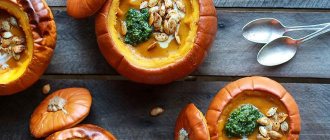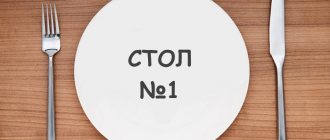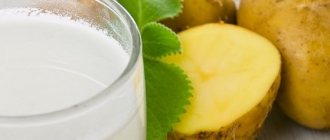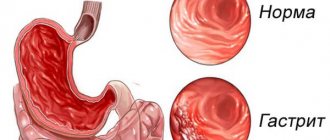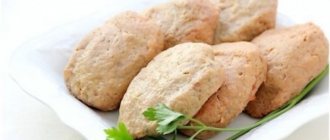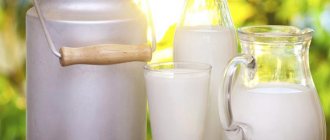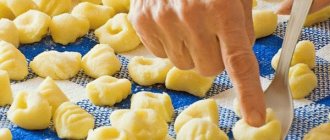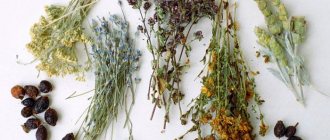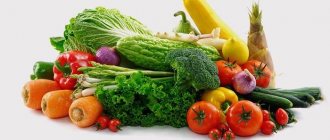Features and rules of diet for cholecystitis
Regardless of the form of the disease, acute or chronic, the nature of nutrition requires compliance with certain rules:
- During an exacerbation, during the first few days, it is necessary to follow a liquid diet. The patient is allowed to drink water, weak tea, low-fat kefir diluted with water.
- After 3-4 days, the introduction of liquid cereals and vegetable soups into the diet is allowed. All dishes to a person suffering from cholecystitis must be served in a ground form, having previously been crushed using a blender or sieve.
- It is important to adhere to a diet, since irregular food intake contributes to exacerbation of the pathology and intensification of symptoms.
- All products must be steamed, boiled or baked in the oven, but without forming a crust.
- A minimal amount of salt and vegetable oil is added to dishes.
- Once every 1-2 weeks it is useful to arrange fasting days, consuming only one ingredient throughout the day. These can be grated apples, dairy products, kefir. Regular fasting days are an excellent prevention of constipation.
Equally important is enriching the diet with foods rich in fiber, which helps to quickly remove cholesterol from the body. Meals should be varied, including optimal ratios of fats, proteins and carbohydrates.
What should be the diet for cholecystitis?
A distinction is made between acalculous and calculous cholecystitis. The first form of the disease, when the walls of the gallbladder become inflamed, affects women more often. In the second case, the pathology is caused by stones blocking the ducts through which bile is excreted. Both forms have many similar symptoms. With acalculous cholecystitis, the patient experiences mild pain in the hypochondrium on the right shortly after eating. In addition to this symptom, belching, nausea, flatulence, and constipation are often observed. With calculous cholecystitis, a characteristic symptom is acute pain in the form of attacks (colic).
The therapeutic diet for cholecystitis - acute and chronic - is largely similar. However, during an exacerbation, the diet has its own characteristics. It is important not to burden diseased organs with food loads. You should eat fractionally, not 3 times, as is customary, but 5-7 times a day. You must eat strictly according to a fixed schedule, at regular intervals. You should swallow food in very small portions, chewing thoroughly.
What can you eat if you have an inflamed gallbladder? It is necessary to think through a detailed diet so that the body receives more proteins than fats and carbohydrates. Food should be boiled, stewed and steamed. Instead of rich first courses, you should prepare lean cabbage soup and vegetable soups. The diet for inflammation of the gallbladder involves eating only warm food.
It is necessary to prepare dishes using only natural products. You will have to give up everything that is difficult to digest and causes flatulence. The diet for cholecystitis, especially during its severe exacerbation, prohibits fatty, fried, hot, spicy, smoked, and sour foods. It is recommended to drink more liquids, their approximate volume is 2-2.5 liters. The best is plain water or mineral water like “Essentuki”, fresh juices.
Articles on the topic
- Chronic duodenitis: how to treat inflammation of the duodenum
- Choleretic drugs for bending of the gallbladder - list and types of drugs, traditional medicine recipes
- Diet for the liver - prohibited and permitted foods for treatment, cleansing and restoration
What can you eat
It is wrong to believe that a person with such a diagnosis is doomed to a meager daily diet. The choice of healthy, tasty products and dishes is very wide. Here's what you can eat for cholecystitis, when the disease does not enter a period of exacerbation:
- vegetable salads;
- lean cabbage soup, light vegetable and milk soups;
- porridges and casseroles;
- lean chicken, turkey, rabbit, beef;
- diet sausages, frankfurters;
- boiled and stewed fish;
- omelette (no more than 2 times a week);
- yogurt, kefir, yogurt, skim milk, cottage cheese, unleavened cheeses;
- dried bran bread, biscuits;
- fresh cucumbers, tomatoes, carrots;
- settled beet juice;
- dishes based on potatoes, beets, eggplants, zucchini;
- dill, parsley, lettuce;
- sweet fruits (especially pears), berries;
- non-acidic juices, jelly, compotes, rosehip infusion;
- weak tea, coffee, preferably with milk;
- honey (1 teaspoon per day), marmalade, jam, marshmallows, marshmallows.
What not to eat
Treatment of calculous and acalculous cholecystitis cannot be effective if the patient allows himself to eat and drink things that exacerbate the inflammatory process. The diet for cholecystitis, especially during exacerbation, strictly prohibits:
- strong alcohol (with the exception of dry red wine in very small doses);
- any fatty first courses;
- pork, lamb, goose, forest game;
- offal;
- smoked meats, canned food, marinades;
- French fries, pasties, pies;
- fatty fish, caviar;
- peas, beans, beans;
- sorrel, radish, radish;
- garlic, horseradish, onion, mustard, vinegar;
- any mushrooms;
- sour fruits, berries;
- strong coffee, carbonated drinks, beer;
- cocoa, chocolate, cakes with rich cream, ice cream;
- fresh bread, sweet products.
Organization of diet
Having decided on an approximate daily menu for cholecystitis, the patient must set a diet for himself. Irregular meals with this pathology can cause complications.
Organizing a proper diet is as follows:
- If possible, meals should be taken at the same time every day.
- You need to eat small portions 5 times a day.
- The patient should avoid overeating, as it can lead to deterioration of health and exacerbation of the disease.
- If you feel hungry between meals, you can drink a glass of low-fat kefir or eat some fruit (for example, an apple).
- During the day you need to drink about 1-1.5 liters of water.
Neglecting the doctor’s recommendations regarding dieting often leads to a worsening of the condition. Therefore, you should not skip meals, overeat, or indulge in unhealthy foods.
Basic principles of nutrition
An important stage in treatment is following certain diets, which differ slightly depending on the pathology and form of the disease.
The main goals of diets include:
- Reduce the amount of stress on the liver;
- Improve the process of bile production;
- Normalize the functioning of all gastrointestinal functions.
Based on these goals, doctors recommend that patients follow the following requirements:
- Eat 5 times a day (no less) and preferably at the same period of time;
- The menu should be structured in such a way that the patient’s body consumes 2100-2500 kcal per day;
- Do not consume drinks and food whose temperature is above or below average;
- Drink plenty of fluids, particularly water;
- Food should be prepared without salt or with a minimum amount of it
- Drinking alcoholic beverages is strictly prohibited.
Products acceptable for illness
Many people, upon hearing their diagnosis from a doctor, are upset, thinking that now they cannot eat most foods. However, there are many interesting recipes consisting of ingredients that are acceptable for cholecystitis.
These products include:
- low-fat cottage cheese, milk, kefir;
- fish;
- chicken, quail meat;
- apples, pears, strawberries;
- cabbage, tomatoes, beets, carrots, potatoes and other vegetables;
- vegetable oil (it is best to use olive oil), which is added in small quantities to salads and other prepared dishes;
- stale bread and unsweetened crackers;
- weak tea.
Also, patients with cholecystitis are allowed to include eggs in their diet, which have a pronounced choleretic effect. It is best to use quail. However, it is important to remember that if there are stones in the gallbladder, this product is contraindicated, as it can provoke an attack of hepatic colic.
Authorized Products
To create a diet, products are used that minimize the load on the gastrointestinal tract and gallbladder:
- flour products - boiled bread, crackers, crackers;
- soups with milk, vegetable and weak chicken broth;
- fresh juices without added sugar, rosehip decoction, compote;
- fruit mousses, baked apples, natural jelly;
- lean meat: rabbit, veal, chicken;
- low-fat sea fish;
- various cereals, durum wheat pasta;
- vegetables and fruits;
- dairy products with a minimum percentage of fat content;
- vegetable oils.
- Wheat bread (grades I and II flour), if tolerated well, you can use rye bread made from peeled flour. Only stale bread is allowed to prevent intestinal bloating. The diet is expanded by introducing dry biscuits, baked savory products with meat, cottage cheese, apples and low-fat cookies.
- Soups are prepared only with vegetable broths with the addition of cereals, noodles and vegetables. You can prepare borscht and cabbage soup, milk and fruit soups. Vegetables should not be fried for seasoning soups.
- For main courses, lean beef, veal, rabbit, and chicken are used. They can be boiled and then baked, served in pieces or chopped.
- Lean fish, boiled seafood salads and fish stuffed with vegetables are allowed.
- You need to choose low-fat dairy products: kefir, acidophilus, yogurt. Milk, since it is poorly tolerated, is added only to dishes. You can use half-fat cottage cheese in its natural form and as part of casseroles and lazy dumplings. Sour cream is used only as a seasoning for dishes.
- Eggs are recommended - omelettes or soft-boiled. Yolks are limited or excluded in cholelithiasis.
- You can eat any cereal in the form of porridge, as an additive to soups and casseroles.
- Various vegetables in baked, boiled and stewed form (sorrel, radish, spinach, radish, mushrooms, garlic are excluded). You can make vegetable salad with vegetable oil and vinaigrettes.
- Non-acidic sauerkraut, green pea puree, and squash caviar are allowed.
- You can use sour cream, vegetable and milk sauces for any meat and vegetable dishes, you can bake with them.
- Among the spices, dill, parsley and cinnamon are allowed in sweet dishes.
- Fruits and berries should be non-acidic; they are consumed fresh and in the form of compotes and jelly.
- Sweets include marmalade, caramel (without chocolate), honey, jam. Sugar is replaced with xylitol (partially).
- Butter and vegetable oil are introduced into the dish in their natural form.
- Recommended drinks: weak tea, weak coffee with milk, vegetable juices, wheat bran decoction, rosehip infusion, still mineral water.
| Proteins, g | Fats, g | Carbohydrates, g | Calories, kcal | |
Vegetables and greens | ||||
| eggplant | 1,2 | 0,1 | 4,5 | 24 |
| zucchini | 0,6 | 0,3 | 4,6 | 24 |
| cabbage | 1,8 | 0,1 | 4,7 | 27 |
| broccoli | 3,0 | 0,4 | 5,2 | 28 |
| carrot | 1,3 | 0,1 | 6,9 | 32 |
| cucumbers | 0,8 | 0,1 | 2,8 | 15 |
| salad pepper | 1,3 | 0,0 | 5,3 | 27 |
| parsley | 3,7 | 0,4 | 7,6 | 47 |
| iceberg lettuce | 0,9 | 0,1 | 1,8 | 14 |
| tomatoes | 0,6 | 0,2 | 4,2 | 20 |
| pumpkin | 1,3 | 0,3 | 7,7 | 28 |
| dill | 2,5 | 0,5 | 6,3 | 38 |
Fruits | ||||
| bananas | 1,5 | 0,2 | 21,8 | 95 |
| apples | 0,4 | 0,4 | 9,8 | 47 |
Nuts and dried fruits | ||||
| raisin | 2,9 | 0,6 | 66,0 | 264 |
| dried figs | 3,1 | 0,8 | 57,9 | 257 |
| dried apricots | 5,2 | 0,3 | 51,0 | 215 |
| dried apricots | 5,0 | 0,4 | 50,6 | 213 |
| prunes | 2,3 | 0,7 | 57,5 | 231 |
Cereals and porridges | ||||
| buckwheat | 4,5 | 2,3 | 25,0 | 132 |
| oatmeal | 3,2 | 4,1 | 14,2 | 102 |
| pearl barley porridge | 3,1 | 0,4 | 22,2 | 109 |
| rice | 6,7 | 0,7 | 78,9 | 344 |
Flour and pasta | ||||
| pasta | 10,4 | 1,1 | 69,7 | 337 |
| noodles | 12,0 | 3,7 | 60,1 | 322 |
| buckwheat noodles | 14,7 | 0,9 | 70,5 | 348 |
Bakery products | ||||
| bran bread | 7,5 | 1,3 | 45,2 | 227 |
| whole grain bread | 10,1 | 2,3 | 57,1 | 295 |
Confectionery | ||||
| jam | 0,3 | 0,2 | 63,0 | 263 |
| jelly | 2,7 | 0,0 | 17,9 | 79 |
| marshmallows | 0,8 | 0,0 | 78,5 | 304 |
| milk candies | 2,7 | 4,3 | 82,3 | 364 |
| fondant candies | 2,2 | 4,6 | 83,6 | 369 |
| fruit and berry marmalade | 0,4 | 0,0 | 76,6 | 293 |
| paste | 0,5 | 0,0 | 80,8 | 310 |
| Maria cookies | 8,7 | 8,8 | 70,9 | 400 |
Raw materials and seasonings | ||||
| honey | 0,8 | 0,0 | 81,5 | 329 |
| sugar | 0,0 | 0,0 | 99,7 | 398 |
Dairy | ||||
| kefir 1.5% | 3,3 | 1,5 | 3,6 | 41 |
| Ryazhenka | 2,8 | 4,0 | 4,2 | 67 |
Cheeses and cottage cheese | ||||
| cottage cheese | 17,2 | 5,0 | 1,8 | 121 |
| cottage cheese 1% | 16,3 | 1,0 | 1,3 | 79 |
Meat products | ||||
| beef | 18,9 | 19,4 | 0,0 | 187 |
| rabbit | 21,0 | 8,0 | 0,0 | 156 |
Sausages | ||||
| boiled diet sausage | 12,1 | 13,5 | 0,0 | 170 |
| boiled milk sausage | 11,7 | 22,8 | 0,0 | 252 |
| milk sausages | 12,3 | 25,3 | 0,0 | 277 |
Bird | ||||
| boiled chicken breast | 29,8 | 1,8 | 0,5 | 137 |
| boiled chicken drumstick | 27,0 | 5,6 | 0,0 | 158 |
| boiled turkey fillet | 25,0 | 1,0 | – | 130 |
Eggs | ||||
| soft-boiled chicken eggs | 12,8 | 11,6 | 0,8 | 159 |
Fish and seafood | ||||
| flounder | 16,5 | 1,8 | 0,0 | 83 |
| pollock | 15,9 | 0,9 | 0,0 | 72 |
| cod | 17,7 | 0,7 | – | 78 |
| hake | 16,6 | 2,2 | 0,0 | 86 |
Oils and fats | ||||
| butter | 0,5 | 82,5 | 0,8 | 748 |
| olive oil | 0,0 | 99,8 | 0,0 | 898 |
| sunflower oil | 0,0 | 99,9 | 0,0 | 899 |
Non-alcoholic drinks | ||||
| water | 0,0 | 0,0 | 0,0 | – |
| mineral water | 0,0 | 0,0 | 0,0 | – |
| green tea | 0,0 | 0,0 | 0,0 | – |
Juices and compotes | ||||
| apricot juice | 0,9 | 0,1 | 9,0 | 38 |
| carrot juice | 1,1 | 0,1 | 6,4 | 28 |
| peach juice | 0,9 | 0,1 | 9,5 | 40 |
| plum juice | 0,8 | 0,0 | 9,6 | 39 |
| tomato juice | 1,1 | 0,2 | 3,8 | 21 |
| pumpkin juice | 0,0 | 0,0 | 9,0 | 38 |
| rose hip juice | 0,1 | 0,0 | 17,6 | 70 |
| * data is per 100 g of product | ||||
We suggest you read: Does running help you lose weight? How much do you need to do to lose weight quickly?
Products prohibited for illness
Despite the rather rich list of allowed foods, many types of food are strictly prohibited for cholecystitis.
Prohibited:
- peas, beans and other legumes;
- spicy, salty, smoked and fatty foods;
- nuts;
- onion, horseradish, garlic, vinegar, mustard, adjika;
- pork, lamb, lard, duck and goose meat;
- canned food and mushrooms;
- chocolate, coffee and strong tea, cocoa;
- creams, cakes and other baked goods;
- alcoholic drinks.
Prohibited ingredients, even in small quantities, can cause harm to health. Therefore, to prevent exacerbation of the disease, you should learn to replace some foods with acceptable ones. For example, instead of cake for dessert, you can make pumpkin or cottage cheese casserole.
Another menu option for the week
You can start Monday with a casserole of cottage cheese, with the addition of raisins, washed down with weak coffee with added milk. Have a fruit salad snack before lunch; apples, pears, nuts and honey will be helpful. For lunch, porridge with water, a steamed cutlet made from permitted meat, and a seaweed salad are acceptable. Wash down lunch with uzvar. In the afternoon, eat a fresh apple or liver, drink jelly. For dinner, prepare a steamed omelet with herbs and vinaigrette.
On the second day, have breakfast with oatmeal with a piece of steamed or boiled veal, and drink rosehip infusion. Snack on banana and cottage cheese. For lunch, have soup with barley and vegetables, you can eat boiled rice and a piece of boiled beef, wash down with compote. Before dinner, have a snack with a vegetable salad with herbs dressed with oil. For dinner you can have milk soup and biscuits.
Wednesday begins with semolina with jam, drink tea with added milk. After a couple of hours, eat a steamed omelette with a slice of bread. For lunch you can have mashed potatoes, boiled fish fillet and vegetable salad. At noon, drink kefir or yogurt with crackers. For dinner, cook pilaf with drying, drink rosehip decoction.
The next day begins with lazy dumplings with cottage cheese, washed down with berry jelly. Before lunch, eat a baked apple or tomato salad, drink tea. For lunch you can have a puree soup based on plant products, as well as boiled chicken breast and uzvar. Before dinner, eat an apple-carrot salad with honey. Dine on macaroni and cheese and drink milk.
On Friday morning you can have milk noodles, bagel and tea. Prepare a casserole of vegetables in advance and eat a piece before lunch, washed down with compote. Have lunch with lean beetroot, boiled beef and plum compote.
Saturday starts with millet porridge with meatballs, washed down with tea and milk. For second breakfast, drink cranberry juice and eat baked pumpkin. For lunch, stew cabbage, make a soufflé of fish or veal with a slice of 2-day-old bread. Half a day allows the consumption of cheese, liver biscuits and tea. Dine with vegetable stew with bread, drink kefir.
Start the last day with chicken fillet pie and weak coffee with milk. Snack on dried fruits with tea. For lunch you can have pilaf with beef, vegetable salad and uzvar. Before dinner, eat a sandwich or cottage cheese with tea, and in the evening, rice with pumpkin, wash down with milk.
The described sample menu for a week can be changed, supplemented and combined, changing dishes.
Features of nutrition in acute form of the disease
The menu for acute cholecystitis should consist of recipes that are most gentle on the gastrointestinal tract, since in this form of the disease inflammatory processes develop quickly, disrupting the functions of the biliary tract.
It is important to limit the diseased organ from overload. For this purpose, patients are allowed to drink only liquids during the first 3-5 days - water, weak tea, diluted low-fat milk.
After the condition improves, thin porridges and pureed vegetable soups are introduced into the diet. Every day, new acceptable ingredients are gradually added to the menu. It is important to remember that after complete recovery, the patient must still follow the diet for some time to avoid complications.
Diet for bile stagnation
In case of poor patency of the biliary tract, it is recommended to include in the diet foods that stimulate the dilution of bile and actively influence the motility of the bile secretion system. It is important to monitor the normal functioning of the intestines.
In case of stagnant processes in the gallbladder and biliary tract, it is recommended to follow the following nutritional rules:
- Eating 5-6 times a day in small portions;
- Avoid temperature changes when eating;
- Distribute the calorie content of meals in the morning, afternoon and evening in equal proportions;
- There are more products that improve peristalsis - they also help dilute bile;
- Eat foods high in magnesium every day - avocados, oatmeal, millet, bananas, beans, nuts;
- Little by little, but daily, include dairy and fermented milk products in the diet to improve the motility of the bile ducts;
- Avoid soups with rich broth;
- Maintain water balance to dilute bodily fluids;
- Cook mainly by steaming and boiling, less often by stewing and baking.
Diet for chronic cholecystitis
Chronic cholecystitis is a complication of the acute form. It often occurs in people who do not follow a diet during the recovery stage. During exacerbations of the disease, the patient must follow rules that are no different from those in the acute form. For the first few days, only water and tea are allowed, then liquid boiled dishes are included in the diet.
With chronic inflammation of the gallbladder, the patient must adhere to a special diet even after the symptoms have completely disappeared. Eating prohibited foods will cause an exacerbation. In addition, if you do not follow your doctor's recommendations, the risk of gallstones increases.
Diet rules
With chronic inflammation of the gallbladder, it is important to eat small and regularly. There should be 5-6 meals per day. You need to eat at the same time in small portions. Thanks to these measures, bile will be produced at the right time and in sufficient quantity. Too cold and too hot can cause spasm of the bile ducts, so food should be consumed warm.
The following foods and drinks will have to be excluded from the diet:
- strong coffee and tea;
- alcohol;
- carbonated drinks, including sparkling mineral water;
- chocolate;
- everything that can irritate the digestive tract - spicy, salty, smoked;
- any canned food and marinades;
- products with food additives (dyes, flavor enhancers, etc.).
Fatty meat is contraindicated in cases of biliary tract pathology
You should limit your consumption of animal fats, sweets and baked goods. So, it is better to give up butter, lard, lamb, pork, fatty fish and poultry (goose, duck meat).
The above rules can significantly reduce the frequency of attacks of chronic cholecystitis. During periods of exacerbation of the disease, as well as when diagnosing acute cholecystitis, in addition to diet, it is necessary to use drug treatment, and sometimes more radical methods. You can learn about how cholecystitis is treated depending on its form in the article: Features of the treatment of acute and chronic cholecystitis using various methods.
Creating a weekly menu
When drawing up a sample menu for the week, you should remember that the list of permitted products is quite large. It’s easy to diversify your diet so that the dishes you eat are practically never repeated.
A sample menu might look like this:
| Breakfast | Lunch | Dinner | Afternoon snack | Dinner | |
| Monday | Semolina porridge, weak sweet tea | Apple or pear | Boiled chicken meat, cucumber and tomato | Dried fruit jelly, sweet cracker | Vegetable cutlets made from carrots and cabbage |
| Tuesday | Oatmeal with apple, rosehip tea | Banana, mashed with a small amount of cottage cheese | Vegetable soup, steamed fish | Cabbage, greens and cucumber salad | A glass of kefir, crackers |
| Wednesday | Low-fat cottage cheese casserole, sweet tea | Handful of dried fruits | Baked meat, cabbage salad | A few slices of cheese, rosehip broth | Boiled fish, boiled zucchini |
| Thursday | Buckwheat porridge, rosehip decoction | Sweet tea, a few crackers | Pumpkin soup puree, boiled egg, tomato | Low-fat yogurt, baked apple | Vegetable stew, tea |
| Friday | Milk porridge with vermicelli, weak tea | Fruit salad of pear and strawberry | Chicken meat stewed with potatoes, cucumber | Cottage cheese with raisins | Pumpkin porridge, fruit juice |
| Saturday | Low-fat cottage cheese, tea with milk | Grated carrots with apple | Fish soup, tomato and cucumber salad | Stewed zucchini, weak tea | Milk porridge with rice |
| Sunday | Pumpkin casserole, rosehip infusion or tea | Low-fat cottage cheese with raisins | Steamed cutlets with wheat porridge, cabbage salad | Tea with milk, a few crackers | Cottage cheese with strawberries and raisins |
Products can be replaced with similar ones, the main rule is not to eat fried or fatty foods, and also not to overeat. Having planned a diet for a week, the patient will not even notice the lack of dishes made from prohibited ingredients, and following a diet and eating regimen will become a useful habit.
Diet No. 5 for cholecystitis of the gallbladder
The purpose of such a diet, first of all, is to improve the process of bile secretion and normalize liver function. The energy value of the diet is 2400-2600 kcal.
Chemical composition of the diet:
- 80 gr. fats, where 55% are of animal origin;
- 80 gr. fats, where 30% are vegetable;
- 400 gr. carbohydrates, 80% is sugar;
- 10 gr. salt;
- At least 2 liters of liquid.
If desired, patients are allowed to consume up to 40 grams. sorbitol
Sample menu for 1 day for diet No. 5:
- First breakfast: cottage cheese mashed with sugar, seasoned with sour cream, tea, oatmeal with milk;
- Second breakfast: several baked apples;
- Lunch: soup without meat, boiled in vegetable oil, boiled chicken, poured with milk sauce, boiled rice and dried fruit compote;
- Afternoon snack: drink rosehip decoction;
- Dinner: fish (boiled in vegetable broth), poured with white sauce, mashed potatoes, cheesecake, tea;
- At night: a glass of kefir.
Recipe examples
To ensure that following your doctor’s recommendations about your diet doesn’t turn into torture, you need to diversify your diet. There are many recipes for delicious dishes, the preparation of which does not take much time.
Recipes for the weekly menu:
- Beet soup with broccoli . Take equal amounts of potatoes, broccoli and beets. Wash all ingredients, chop finely and place in boiling water. When the vegetables soften, add a small amount of salt.
- Pumpkin puree soup . To prepare the dish you will also need a small amount of milk. The pumpkin needs to be peeled and finely chopped. Pour in water and bring to a boil. Next, pour milk into the soup and leave on low heat for 10-20 minutes, stirring constantly. After this, add salt or sugar and grind the dish using a blender.
- Lean fish soup . Peel and chop potatoes and carrots. Boil the fish until cooked, add the remaining ingredients to the soup. Salt the finished dish, add herbs.
- Carrot casserole . Grate one medium apple, add beaten egg and a small amount of sugar. Mix the resulting mixture with chopped carrots and a small amount of cottage cheese, bake for 25-30 minutes.
- Steam cutlets . Add grated carrots and potatoes to the minced chicken. Mix with beaten egg and add a little salt. Form small cutlets from the resulting minced meat and steam for about 30-40 minutes.
- Stuffed pepper . Mix minced chicken with boiled rice until half cooked. Pre-core the sweet peppers, rinse them and fill them with filling. Place everything in a small container, add grated carrots, and add water. Simmer over low heat for 45-55 minutes.
- Vegetable and chicken breast salad . Boil 1-2 eggs, chop finely. Chop the cabbage. Cut the pre-boiled chicken into small slices and mix all the ingredients. You can dress the salad with olive oil or low-fat sour cream.
The ability to add many dishes from permitted foods to your diet will not only relieve the discomforting symptoms of the disease, but will also help normalize stools, get rid of excess body weight, and reduce the likelihood of complications to a minimum.
By following all the rules of the diet, the patient will be able to forget about the manifestations of pathology for a long time. If you have any questions, you should consult your doctor. He will give recommendations on the nature and diet, help solve the problem of creating a menu for the week, and talk about possible complications with cholecystitis.
It is important to remember that illness is not a death sentence - you need to take care of your health by taking medications and following a diet.
Author: Natalya Korol, doctor, especially for Zhkt.ru
General rules
Cholecystitis is an inflammatory process occurring in the gallbladder. The disease is infectious in nature, which can be bacterial, viral and parasitic. An important factor in the development of this process is the stagnation of bile, as well as changes in its chemical properties; the use of bile-excreting agents is indicated.
There are several forms of the disease. In gastroenterological practice, acalculous and calculous cholecystitis are distinguished. The inflammatory process can be catarrhal and purulent.
Patients complain of acute pain in the right hypochondrium in the area of the gallbladder. The syndrome intensifies after eating non-recommended foods: fatty, fried, salty, drinking beer and mineral water. Dull pain occurs in chronic conditions. Sharp attacks that can radiate to the shoulder blade, shoulder and neck area are characteristic of exacerbation. The patient is also concerned about flatulence, diarrhea and constipation, nausea and vomiting. When cholecystitis and pancreatitis occur together, loose stools are possible.
For cholecystitis and pancreatitis, you must follow the following diet rules:
- Regular meals, excluding fasting and overeating. You need to eat 2-3 times a day and have several nutritious snacks.
- You need to take food in small portions, get up from the table without feeling hungry.
- The temperature of food consumed should be no more than 40–45 degrees.
- Food should be soft, so as not to put a strain on the digestive organs; foods containing fiber should be avoided.
- Food should be steamed, baked, boiled; fried food is completely excluded.
- Limit the consumption of eggs to 3 eggs per week. It's better to eat only protein.
These are general rules that apply to various diseases of the gastrointestinal tract.
In case of a combined course of diseases, the food should be homogeneous. It needs to be crushed to a puree. Various sauces and seasonings are completely removed from the diet. Meat should be in the diet, but it should be lean. It is better to exclude pork, lamb, and duck.
The following products are allowed to be consumed:
- yesterday's bread, Armenian lavash and oven-dried crackers, without adding spices;
- baked apples, zucchini, beets;
- low-fat kefir, sour cream 15% fat, natural yogurt, fermented baked milk;
- decoctions and compotes, homemade juice without added sugar, tea with milk;
- buckwheat, semolina and oatmeal;
- lean meat, poultry and beef;
- soups with vegetable broth, pureed chicken and potato soup.
It is better to use vegetable oil and avoid animal fat. In the chronic course of these pathologies, nutrition should be balanced. Dishes are prepared from permitted ingredients, but their list is gradually expanding somewhat. If the patient's condition worsens after changing the diet, liquid meals are reintroduced.
The patient's menu is compiled in accordance with the recommendations for dietary table No. 5 and 2 according to Pevzner. The basic principle of diets is to maintain the protein and carbohydrate content while reducing the intake of fat. It is necessary to increase the amount of plant fiber and liquid consumed in the diet. You should not take cold or too hot food, sour, rough and spicy foods that injure the gastrointestinal tract.
The list of products allowed for this disease includes:
- bread made from 2 types of flour with added bran, yeast-free baked goods;
- vegetable, milk soups;
- lean meats and cooked sausages (limited);
- low-fat sea fish;
- dairy products with fat content up to 4%;
- steam omelettes and soft-boiled eggs;
- buckwheat, oatmeal, rice cereals;
- pasta, beets, potatoes, zucchini;
- fruits and dried fruits;
- candies without chocolate, natural honey;
- berry fruit drinks, decoctions and compotes, tea;
- vegetable and butter, but limited.
An approximate menu for a patient with combined gastritis and cholecystitis for one day is as follows:
- For breakfast, you can eat oatmeal with milk with one soft-boiled egg, and drink a glass of green tea.
- The second breakfast can be made from cottage cheese with the addition of low-fat yogurt.
- For lunch, soup with pasta and vegetables, stewed cutlets and mashed potatoes, and compote are allowed.
- For an afternoon snack, drink jelly with biscuits.
- For dinner, rice casserole with dried apricots and kefir are acceptable.
This is an approximate recommended menu. Its changes should be discussed with a gastroenterologist or nutritionist.
By following a diet, you can stop the inflammatory process and restore the integrity of the affected mucous membranes. The following products are allowed during the treatment period:
- boiled chicken or rabbit meat, steamed or baked;
- low-fat cottage cheese and milk;
- puree from non-acidic fruits or vegetables;
- mineral water, apple compote, berry fruit drinks or jelly;
- various vegetables, preferably boiled beets and carrots;
- low-fat fish, such as pink salmon or hake.
In case of acute inflammation of the gallbladder, it is necessary to provide rest to the affected organ and remove excess stress from the organs of the digestive system. During an exacerbation, it is necessary to limit the amount of food consumed, and in the first 2-3 days it is better not to eat at all. Liquids must be taken in sufficient quantities.
On day 2, fresh tea is allowed. On the third day the patient feels better. For breakfast you can eat oatmeal. The size of its portion is determined by the patient’s well-being, but overeating should be excluded. For lunch, you can eat soup with meat broth and sweet berry puree.
After the pain subsides and digestion is restored, you can eat lean meat. It is better if the dish is prepared from minced meat. Dairy products, dried wheat bread, and steamed fish are gradually returned to the diet. After 1–1.5 weeks, the patient’s condition returns to normal; he is recommended to follow the recommendations of treatment table No. 5a.
We invite you to read Catherine Zeta-Jones' Soup Diet reviews
The patient gradually returns to normal eating. The daily calorie intake should be in the range of 2400–2700 kilocalories. When drawing up a menu, the nutritionist takes into account the following proportions: about 70% of the diet should be carbohydrates, proteins and fats 15%. During the day, the patient should drink a lot of fluid, at least one and a half 2 liters.
General recommendations:
- Steamed dishes are considered the healthiest. It is permissible to cook food in water.
- Baked vegetables, meat and fish can also be included in the diet, but provided there is no fried crust. The dish should be cooked at low temperature or add a little water to the baking tray.
- It is better to eat vegetables raw, but in a puree state. Such salads are seasoned with a small amount of refined vegetable oil.
- Soups are prepared in vegetable or weak chicken broth without frying.
- Porridges should be included in the daily diet of a patient with chronic cholecystitis; they contain a lot of carbohydrates and fiber. Cereals are cooked not only in water, but also in skim milk.
- Salt consumption is limited.
Any foods that provoke an attack of biliary colic are prohibited. These include: onions, garlic and radishes.
This is a chronic pathology diagnosed when a stone forms in the gallstone. During the treatment period, the doctor may recommend taking choleretic decoctions, but you should not use them without first consulting the doctor. An approximate menu for a patient with this disease is as follows:
- protein foods, namely steamed meat or fish;
- fermented milk products without unnecessary additives and low fat concentration;
- cereals as a side dish or as part of first courses;
- vegetables and fruits, thermally processed;
- fresh juices diluted with water to a low concentration;
- boiled egg white or as part of a steam omelet;
- dried fruits prepared without added sugar;
- vegetable oils (olive and sunflower);
- low-fat cottage cheese and low-fat sour cream.
The listed products can be combined with each other to prepare complete meals from them. By adding additional ingredients to your diet, you need to control your own well-being. If a new food causes pain or a change in condition, you should avoid it.
This is an acalculous form of the disease. It is formed when there is a source of infection in the body. Pathogens are thrown into the gallbladder from the intestines. These can be enterococci, E. coli and helminthic infestations. With this type of inflammation, nutrition should be complete, but gentle.
Fatty, spicy and fried foods are excluded from the menu. Food must be taken regularly, this is necessary to normalize the flow of bile. It is worth giving up alcohol consumption, because treating diseases involves the use of antibacterial drugs. Dishes rich in cholesterol are removed from the daily menu. Sweets, marinades, fatty and fried foods are prohibited.
If you follow a diet, the disease has a favorable outcome, but the patient must take into account all the doctor’s recommendations. With constant relapses, the risk of developing hepatitis increases. cholangitis and other complications.
In the first days of acute cholecystitis, the child is advised to drink plenty of fluids. This could be sweet tea, rosehip infusion, vegetable and fruit juices, berry fruit drinks. Gradually, easily digestible dishes are introduced into the menu:
- pureed soups with vegetable or chicken broth;
- milk porridge with buckwheat and semolina;
- vegetable and fruit puree
- boiled meat and fish.
In the chronic course of the process, consumption of milk and fermented milk products, cottage cheese is allowed. Only easily digestible fats are allowed to be used. These include vegetable oil and butter.
The list of prohibited products is extensive:
- rye bread and fresh white;
- flour products from butter and yeast dough;
- smoked meats, sausages, canned food;
- fatty rich broths;
- chocolates and sweets in large quantities;
- coffee drinks and cocoa;
- carbonated sweet drinks.
Useful menu recommendations
It is best to cook food by steaming, boiling, baking in the oven without fat and oil, or stewing in water. Make sure that the amount of table salt does not exceed 8 g per day, because it also tends to irritate the mucous membranes, in addition, it retains water in the body. There are many interesting recipes, which you can study in specialized literature or on thematic websites. You won't have to starve or suffer from monotony on this diet.
Approximate menu of a therapeutic diet for the day:
- We have breakfast with cottage cheese soufflé, a small portion of oatmeal with dried fruits, and drink a cup of weak coffee with milk.
- Snack on fresh or frozen berries
- We have lunch with vegetable soup with buckwheat, steamed rabbit meatballs, fresh vegetable salad dressed with olive oil, and drink a glass of dried fruit compote
- For an afternoon snack we eat a baked pear or apple
- We will have dinner with boiled vegetables, steamed pike perch cutlets, and for dessert we will have natural fruit jelly
- Before going to bed, we can drink a glass of natural low-fat yogurt without additives and eat a piece of toasted bread.
With stoneless
Chronic acalculous cholecystitis is an inflammation of the gallbladder in which the outflow of bile is disrupted, but stones do not form. Diet therapy is one of the important components of treatment. It is recommended to eat frequently - 4-6 times a day, so that the gallbladder is emptied regularly.
You can’t eat fatty, spicy and fried foods. Strong alcoholic drinks, wines and beer are prohibited. It is recommended to avoid nuts, baked goods, fresh vegetables and fruits, cold foods, and egg yolks. During an exacerbation, you should only eat freshly prepared warm food, boiled, steamed or baked.
Recipes for menus for cholecystitis
Now we list several recipes that can be used while following a diet after cholecystitis and during the treatment process:
Squid soup
- cook the broth with thinly sliced squid;
- after the soup boils, add Brussels sprouts, diced cucumbers and chopped herbs;
- let the soup boil for 5 minutes and then it can be served.
Ground beef cutlets
- make minced beef
- add diced carrots and onions to it
- lightly pepper and salt the minced meat
- add an egg to it
- form cutlets and steam them
Fish soufflé
- make minced fish, add spices and salt to it
- mix minced meat with eggs
- beat the egg white separately and pour it over the minced fish
- pour everything into a baking tray and place in the oven
Stuffed peppers in tomato juice
- 6 large bell peppers,
- 0.5 kg beef or chicken breast,
- tomato juice (1 glass),
- boiled rice (3 tablespoons),
- carrots (1-2 pcs.),
- onions (2 pcs.).
You need to cut off the bottoms of the peppers, remove the seeds and rinse thoroughly outside and inside. Grind the meat in a meat grinder. Simmer chopped onions with grated carrots with a little water, mix with rice and minced meat. Stuff the peppers with the resulting mixture, place them in a high frying pan and pour in tomato juice. When the liquid boils, reduce the heat and simmer the dish for 50-60 minutes. You can also stew the peppers in the oven.
Vegetable puree soup
The recipe for this dish for cholecystitis can be modified by changing the composition, quantity and ratio of vegetables.
- potatoes (5 pcs.),
- zucchini (300 g),
- carrots (2 pcs.),
- eggplants (2 pcs.),
- onion (1 pc.),
- olive oil (2 tablespoons),
- fresh herbs (dill, parsley),
- sweet pepper (2 pcs.).
All vegetables should be washed, peeled and cut into small pieces. First, place the potatoes in boiling water, after 10 minutes add all the remaining vegetables, except zucchini, add them 5-10 minutes before the dish is ready. When the zucchini also becomes soft, add salt to the soup, cool slightly and puree using a blender. You can also strain the vegetables through a metal sieve. Season with oil and add chopped herbs.
Baked apples
- cottage cheese (100 g),
- apples (4 large),
- egg,
- sugar (2 tablespoons),
- crushed walnuts.
Baked apples with curd filling are a delicious and healthy dessert that can be included in the diet for cholecystitis.
The apples must be washed and the cores removed with a knife. Grind the egg yolk with sugar, mix with cottage cheese, add nuts to the mixture. Stuff each apple and sprinkle cinnamon on top.
Moisten a baking sheet with water, place apples on it and bake them for 15-20 minutes. This dish can be used as a dessert for cholecystitis: stuffed baked apples will taste as good as a sweet cake. To make them even healthier, you can replace sugar with honey and add raisins.
Dish recipes
Dietary nutrition affects intestinal motility, the rate of food digestion, and the secretory activity of the liver. The effectiveness of conservative treatment largely depends on the balance of the diet and menu variety.
Soups
Most broths (meat, mushroom) are undesirable for cholecystitis. Therefore, they are replaced with dietary soups:
- Pearl barley. The cereal is cooked until half cooked. Simmer chopped onions and grated carrots over low heat. Stewed vegetables and potato cubes are added to barley.
- With zucchini. Small onions and carrots are chopped and simmered over low heat with butter. Potato cubes are added to the vegetable broth, and after 20 minutes, chopped tomatoes and zucchini are added. If desired, season the soup with low-fat sour cream and sprinkle with herbs.
- From rice. Boiled cauliflower and potato cubes are ground through a sieve. The rice is boiled for at least 50 minutes, then ground and added to the vegetables. Season the cream soup with a piece of butter and skim milk.
It is strictly not recommended to add frying cooked in oil to soups. Ready-made dishes are served with rye bread or crackers.
Second courses
Do not eat cold snacks for cholecystitis. Second courses are used as a replacement:
- Meat soufflé. The boiled chicken fillet is ground in a meat grinder, a little milk, salt and 1 beaten egg white and yolk are added. Place the mixture in an oiled frying pan and place in the oven for 10 minutes. Bake at a temperature of 170-180°C.
- Fish with vegetables. Finely chop the zucchini, carrots and onions. Boil the potatoes. Place the prepared vegetables on a baking sheet and place fish fillets on top. Season with low-fat sour cream and bake in the oven for 15 minutes.
Diet No. 5 allows stuffed vegetables with dietary meat, steamed beef cutlets, and chicken casserole.
Salads
The menu for cholecystitis includes vegetable salads:
- Cabbage. Shred white cabbage and season with lemon juice. Grind with a small amount of granulated sugar and add chopped carrots. Season the salad with olive oil.
- Beetroot. Small beets are boiled and chopped into strips. Add 100 g of chopped dried apricots, 2 tbsp. l. sugar and 100 g low-fat sour cream.
Vegetable salads have a stimulating effect on intestinal motility and eliminate problems with stool. Therefore, they are included in the diet for calculous, sluggish and non-calculous cholecystitis.
Dessert
Proper nutrition does not exclude the intake of sweets, but they should not contain prohibited foods. As part of diet No. 5, you are allowed to cook:
- Marmalade. 1.5 cups of cherries sprinkled with 2 tbsp. l. Sahara. The thoroughly mixed mass is crushed in a blender. Add 2 tsp to the puree. agar-agar and leave for 20 minutes. Bring the mixture to a boil over low heat, stirring constantly. Pour the berry puree into molds and cool for 25 minutes.
- Baked apples. Core the apples by pouring a little sugar or honey into the holes. Place the fruit on a baking sheet and add a little water. Bake for 10 minutes.
Diet is a physiological balanced nutrition program that is aimed at restoring the functions of the gastrointestinal tract. Due to the variety of approved products, it is easily tolerated by patients with cholecystitis. Compliance with it prevents relapses of the disease, problems with stool and liver.
Proper nutrition during remission
In case of chronic cholecystitis without exacerbation and in acute form during the recovery period, patients are shown a special diet 5. This is a balanced and varied diet that excludes the consumption of too fatty foods, simple carbohydrates, vegetables and herbs with extractive substances and alcohol. It is these products that provoke the release of bile, create additional stress on the liver and can cause a new attack or transition from the acute stage of the disease to the chronic stage. When the most serious symptoms subside, treatment is carried out only with proper nutrition.
The following products are completely excluded from the menu:
- fatty meats and fish, caviar;
- meat, fish and mushroom broths;
- meat by-products;
- canned food;
- semi-finished products;
- fast food;
- mushrooms;
- pickles and marinades;
- yeast baked goods, fresh bread and puff pastry products;
- radish, radishes, turnips, sorrel, spinach and green onions;
- sour fruits and berries;
- egg yolk, only 0.5 pcs allowed. per day as part of other dishes;
- all fried foods;
- hot sauces and spices;
- chocolate;
- refractory fats, confectionery creams;
- ice cream;
- strong black coffee;
- carbonated drinks;
- sour pickled vegetables;
- alcohol.
If you know what you shouldn't eat, you can carefully control your diet. Strict adherence to all the rules will help you recover quickly and achieve long-term remission.
It is very important to eat at the same time every day, this will prevent bile stagnation and re-inflammation of the gallbladder.
The menu on diet 5 will consist of the following products:
- lean meats;
- lean fish;
- vegetables in any form, except prohibited ones;
- sour sauerkraut;
- herring soaked in milk;
- porridge and cereals;
- yesterday's or dried yeast-free baked goods;
- ripe, non-acidic fruits, especially useful when baked;
- low-fat dairy and fermented milk products;
- unsalted and mild cheeses with a small percentage of fat content;
- non-acidic berries;
- protein steam omelettes, but no more than once or twice a week;
- refined vegetable oils;
- butter, but in limited quantities;
- candies without chocolate, marshmallows, marshmallows, jelly, fruit mousses;
- weak coffee with milk, no more than 1 cup per day;
- weak tea;
- infusions of medicinal herbs;
- still mineral water.
From the list it is clear that you can eat a lot of foods, and if you combine them with inspiration, you will get tasty and healthy dishes.
What foods and dishes can you eat during an exacerbation of cholecystitis?
Nutrition during exacerbation of cholecystitis is a complete and balanced diet. Allowed foods included in the diet fully meet all the body's needs for calories, vitamins and minerals.
A variety of factors in everyday life can provoke periods of exacerbation in chronic patients, ranging from shaking in public transport to banal hypothermia.
Permitted and recommended products for exacerbation of cholecystitis:
- steamed or baked rabbit meat;
- baked turkey or chicken with vegetables;
- fish soup on lean fish;
- fish steamed or baked in its own juice, it is advisable to avoid fatty varieties (mackerel, salmon, etc.);
- milk porridge;
- vegetable soups (except onion);
- eggs, omelet (no more than one per day);
- refined vegetable oils as a salad dressing;
- cottage cheese, curdled milk, whey, unsweetened yoghurts;
- Cheeses allowed include feta cheese and goat cheese;
- almost all fresh vegetables;
- fruits, citrus fruits, berries;
- juices, it is recommended to consume fresh vegetable juices (beetroot, carrot) daily;
- weak tea, coffee;
- bread;
- compote, jelly.
During exacerbation of cholecystitis, it is advised to avoid sweets, but for those who cannot imagine their diet without desserts, it is strongly recommended to eat only cottage cheese casseroles, soufflés, marshmallows, puddings, and jams prepared at home.
The diet menu for exacerbation of cholecystitis should include the daily consumption of fermented milk products containing beneficial bacteria. To strengthen your immune system, you need to eat more kiwi and sauerkraut (not sour cabbage).
